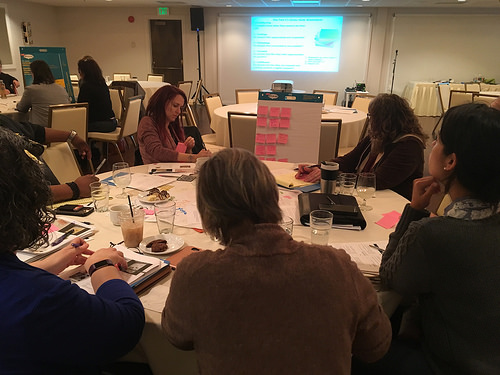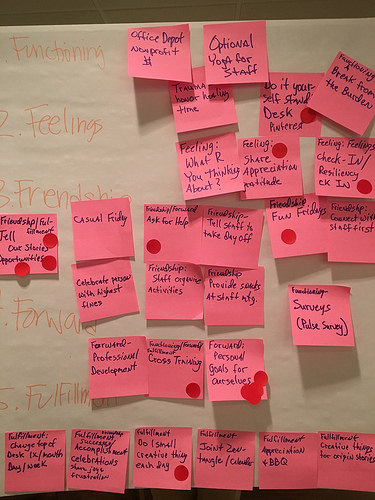
Last month, I was honored to present and facilitate an all-day workshop for nonprofit leaders at the Oregon Nonprofit Leadership Conference on how to activate a culture of well being in the nonprofit workplace, based on my book, The Happy Healthy Nonprofit: Strategies for Impact without Burnout. I also delivered a workshop to South Carolina nonprofits on the same topic hosted by Shine The Light, Nonprofit Forums. The participants were amazing and came up with some terrific strategies and action plans.
Many times the reaction to focusing on organizational culture and wellbeing is considered “soft” or “nice” stuff that not lead to results or impact. There is now enough evidence from research that focusing on resilience in the workplace is an essential strategy for sustainable results.
And there is another reason to focus a culture of wellbeing. We are living in an age of radical transparency, powered by movements like #metoo, it is beginning to shine a light on toxic nonprofit workplaces for all to see what was once hidden. Potential job applicants are beginning to place as much emphasis on positive organizational culture as they do on job tasks and salaries. This means activating a culture of well being in the nonprofit workplace is even more important to avoid turnover and attract top talent. Organizational culture really matters when it comes to high performance and results.
The workshop focused on how nonprofit leaders can activate a culture of wellbeing in their organizations. Leadership skills are only just about our inner-selves, it is also how we relate to other people and manage those relationships, especially in the workplace. If we lack the skills to avoid collaborative overload, manage difficult conversations, learn from failure, the resulting physical, emotional, and mental strain gets in the way of a nonprofit organization’s success. Why? Because staff turnover challenges effectiveness and poor morale does not inspire staff to move the organization’s forward to great heights.
One of the workshop exercises was to teach leaders a process they can facilitate back in their organizations to begin the discussion about how to activate a culture of well being. I use framework developed by Laura Putnam, from her book, Workplace Wellness that Works.The framework helps us better understand and how to shift organizational culture. The framework is based on Abraham Maslow’s hierarchy of needs, mapped to an organization’s hierarchy of needs:
• Level 1: Functioning Factor – Do people have what they need to do their job?
• Level 2: Feelings Factor – Do people feel appreciated and respected?
• Level 3: Friendship Factor – Do people feel connected to one another?
• Level 4: Forward Factor – Do people feel like they have opportunities for growth?
• Level 5: Fulfillment Factor – Do people feel like they are inspired and working towards a higher purpose?

As part of the set-up to the exercise, I share some examples from the Happy Healthy Nonprofit: Strategies for Impact without Burnout. Then, I have participants work in small groups, using a structured brainstorming process. We had a dozen small groups that each brainstormed 20-50 ideas each. Participants prioritized the ideas by combining and evaluating the cost/impact, boiling down to a couple of ideas to present to the whole group.
Participants were able to share what they were doing to activate a culture of wellbeing with each other as well as come up with new ideas. Here’s the list:
Function
- Building basic processes for getting work done, for example collaborative calendar planning
- Enough staff to cover work or prioritize work flows
- Improve internal information systems
- Responsive tech support
- Make sure there are enough basic supplies
- Sound proof the office
- Better lighting in office, natural light
- Adequate desks and chairs for how people want to work
- Encourage staff to take breaks, go outside to get fresh air
- Healthy food and snacks available at meetings
- Use surveys to find out what staff need
- Remote working policy with flexibility
- Flexible hours to accommodate personal time
Feelings
- Clear expectations with supervisor and employee through regular check-ins
- Give real-time feedback and praise, established feedback loops for employees
- Work anniversary celebration, shout outs to staff, hand-written gratitude notes
- Birthday cards from the board, celebrate staff birthdays at monthly staff meeting, give staff member the day off for their birthday
- Whiteboard of love – written praise for staff accomplishments,
- Reserved parking space awarded to an employee each month who had done a great job
- Ritual of staff praise at meetings or monthly award, not just a raise
- 80/20 rule – 20% leaders talk at meetings
- Do walking meeting one-on-ones and train staff to listen to each other
- Start meetings with a feelings check-in – how are you feeling today
- Encourage genuine curiosity for others’ wellbeing
- Encourage more dialogue and discussion at staff meetings, team retreats
- Create safe space to discuss any negative issues,
- Provide clear procedure for reporting grievances or complaints so people feel heard
- Honor healing time needed to heal from trauma from work if working with vulnerable populations
- Review self-care activities and celebrateFriendship
- Establish norms around compassionate behavior and modeled by SLT
- Motivation Monday, Taco Tuesday, Waffle Wednesday, etc.
- Staff goes out of the building for a meeting at least once a quarter
- Understand diversity and blind spots and how they might hurt people
- Casual Fridays or “Fun Fridays”
- Encourage staff to ask for help
- Give comp time or days off after stressful weeks
- Do fun icebreakers at meetings and other team building activities
- Hike during staff retreat
- Connect through moments of play
- Take other teams out for lunch
- Ice Cream for staff appreciation or other staff organized social activities
- Gift exchanges or potluck not during the holidays
- Volunteer on a project together
- Leadership training on communications styles
Forward
- Robust on boarding program
- Special projects that are professionally fulfilling and interesting
- Promote from within
- Include personal growth in professional development plans
- Encourage staff to be creative or do creative things
- Asking about career goals and how they might be pursued at current job
- Paid volunteer team at another org
- Encourage sharing what is learned at conferences with staff
- Professional development plans/funds
- Create a leadership library of nonprofit books for staff to check out and read
- Allow staff to identify “stretch assignments”
- Mentoring program and cross training
- Create a norm about respecting work in progress and need for quiet time
- Minimum mandatory meetingsFulfillment
- Annual retreat to remember why everyone does the work and be client focused
- Celebrate our organization’s accomplishments once a month – but also share frustrations as well as joy
- Have staff share their origin stories, why passionate about nonprofit work
- Mission moments – photos, videos, make them visible
- Mission statement and values on the wall
- Staff meetings that have some time to share accomplishments, not just problems
- Transparency
- Create mission moments collage and put on the wall
- Accomplishment wall related to mission/program success
- Field trips to visit programs and clients
Working on improving workplace culture is always a work in progress. But an exercise like this done with your staff can generate a lot of great ideas and help your team land on a small pilot to work on. If you are curious about the implementation requirements for any of these ideas – many are low cost – The Happy Healthy Nonprofit: Strategies for Impact without Burnout has more.

Leave a Reply